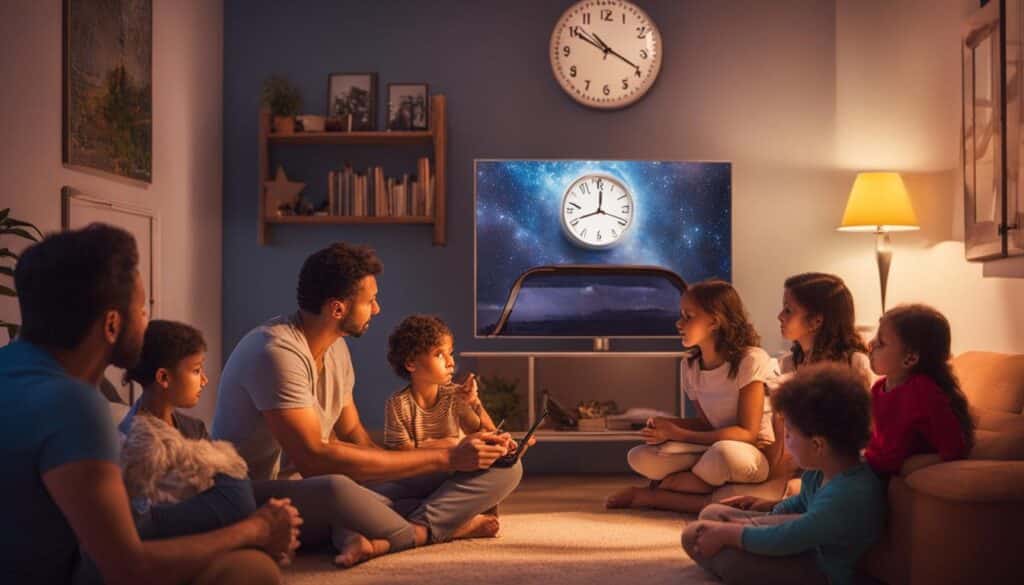Managing Technology Use in Your Family
In today’s digital age, managing technology use in the family is crucial for maintaining a balanced digital life. As a parent, I understand the challenges and benefits that come with incorporating technology into our daily routines. It’s essential to approach technology use in a way that enhances our lives rather than overwhelming them.
So how do we strike the right balance? By setting rules, being role models, and encouraging the use of good-quality content, we can create a safe and enjoyable digital environment for our families. Let’s explore these strategies further.
Key Takeaways:
- Set clear rules for technology use in your family.
- Be a positive role model for healthy screen time and digital technology use.
- Understand your child as a technology user and tailor guidance accordingly.
- Encourage the use of good-quality content to enrich your child’s digital experiences.
- Negotiate and regularly revisit rules for family screen time and digital technology use.
Be a Role Model for Healthy Screen Time and Digital Technology Use
Being a role model for healthy screen time and digital technology use is essential. As a parent, I understand the importance of setting a positive example for my children and creating a safe and balanced digital environment in our family. By being mindful of my own phone usage, tracking my screen time, and discussing my apps and online activities with my children, I can foster an open dialogue and encourage responsible screen time habits.
Tracking Screen Time
Tracking screen time is a helpful tool in managing technology use. By monitoring the amount of time I spend on digital devices, I can ensure that I am practicing healthy screen time habits. There are various apps and settings available on smartphones that can help me keep track of how much time I spend on different apps and websites. This allows me to be aware of my digital habits and make necessary adjustments if needed.
Being Mindful of Phone Usage
Being mindful of my phone usage is another important aspect of being a role model. I make a conscious effort to put my phone away during family time and prioritize face-to-face interactions. By setting boundaries and not constantly being glued to my phone, I show my children the importance of being present in the moment and establishing a healthy relationship with digital technology.
Discussing Apps and Online Activities
Engaging in discussions about apps and online activities with my children creates an open and safe environment for them to share their experiences and concerns. I encourage them to talk about the apps they enjoy using and the content they come across online. This allows me to guide them towards age-appropriate and educational content while addressing any potential risks or challenges they may encounter.
“Being a role model for healthy screen time and digital technology use is essential. By being mindful of my own phone usage, tracking my screen time, and discussing my apps and online activities with my children, I can foster an open dialogue and encourage responsible screen time habits.”
Incorporating a Balanced Approach
Incorporating a balanced approach to screen time means striking a healthy balance between digital technology use and other activities. I make sure to emphasize the importance of physical activity, outdoor play, reading, and other offline hobbies. By modeling a diverse range of activities, I teach my children the value of a well-rounded and balanced lifestyle.
| Benefits of being a role model for healthy screen time and digital technology use | Actions to take |
|---|---|
| Developing responsible screen time habits | Track screen time and set limits |
| Creating an open dialogue | Discuss apps and online activities |
| Promoting a balanced lifestyle | Encourage offline activities and hobbies |
| Fostering a safe digital environment | Address risks and challenges |
Table: Benefits of being a role model for healthy screen time and digital technology use
By being a role model for healthy screen time and digital technology use, I can positively influence my children’s relationship with digital devices. Through mindful phone usage, tracking screen time, discussing apps and online activities, and promoting a balanced lifestyle, I am shaping responsible digital citizens who can navigate the online world safely and make informed choices.
Get to Know Your Child as a Technology User
Understanding your child as a technology user is crucial for guiding their screen time and digital technology use. By asking them about their digital technology interests, needs, and worries, you can tailor your guidance to suit their specific requirements. This helps create a supportive environment that promotes responsible technology use.
It’s important to have open and honest conversations with your child about their digital experiences. By actively listening to their concerns and interests, you can address any worries they may have and provide appropriate guidance. For instance, if your child feels anxious about not being able to respond immediately to messages from friends on social media, you can help them develop strategies to limit their social media use and set boundaries that align with their needs.
Encouraging Healthy Social Media Use
Social media is a common area of interest for many children. While it provides opportunities for connection and self-expression, it’s important to teach your child about responsible social media use. Set clear guidelines for what is appropriate and safe, including privacy settings and the types of information they should avoid sharing online. Encourage them to engage with positive and meaningful content that reflects their interests and values.
Parental involvement and open communication play a crucial role in helping children maintain a healthy relationship with social media. By setting limits and ensuring a balance between online and offline activities, parents can guide their children towards responsible digital citizenship.
It’s also important to keep in mind that each child is different. While some may have a keen interest in technology, others may feel overwhelmed or disinterested. By understanding your child’s individual needs and worries, you can make informed decisions about their technology use, ensuring it remains a positive aspect of their lives.
Use Good-Quality Content
Encouraging the use of good-quality content is essential for promoting a balanced digital life for children. As parents, we have the opportunity to introduce our children to a wide range of interests and activities through carefully selected apps, games, TV shows, movies, and YouTube videos.
By showing our children examples of good-quality content, we can help them develop a discerning taste and appreciation for age-appropriate media. This not only exposes them to enriching experiences but also ensures that their digital adventures are safe and educational.
When selecting content, it’s important to consider reliable reviews to make informed choices. By consulting trusted sources, we can gain insights into the content’s educational value, appropriateness for different age groups, and potential risks or concerns.
Reliable reviews can provide valuable guidance in identifying content that aligns with our children’s interests while also prioritizing their safety and well-being.
Engaging in discussions about the information, ideas, and activities presented in the media is also crucial. By sharing our perspectives and asking open-ended questions, we can foster critical thinking skills and encourage our children to see beyond the surface of what they consume.
In this digital age, where the availability of content is vast and varied, it’s our responsibility as parents to curate a media diet that nurtures our children’s development. By offering good-quality content that aligns with their interests, we can empower them to explore, learn, and create in a safe and educational digital environment.

Examples of Good-Quality Content
| Type of Content | Example |
|---|---|
| Apps | BeeBot – an interactive coding game that introduces children to fundamental coding concepts through engaging challenges. |
| Games | Minecraft – a sandbox game that encourages creativity, problem-solving, and collaboration in a virtual world. |
| TV Shows | Sesame Street – an educational show that teaches early literacy, numeracy, and social skills through fun and engaging segments. |
| Movies | Inside Out – an animated film that explores emotions and encourages emotional intelligence and empathy. |
| YouTube Videos | CrashCourse Kids – an educational YouTube channel that covers a wide range of subjects through informative and entertaining videos. |
Negotiate Rules for Family Screen Time and Digital Technology Use
When it comes to managing technology use in the family, setting clear rules is essential. However, it’s equally important to involve the whole family in the rule-making process. By negotiating rules together, you can create a collaborative and supportive environment that accommodates everyone’s needs and interests.
Start by having open discussions about family screen time rules. Consider when and where devices can be used, which apps and websites are off-limits, and what information is safe to share online. Establishing boundaries and guidelines will help ensure a safe and healthy digital experience for all family members.
Remember that rules should be flexible enough to adapt to the ever-changing needs and interests of your child. As they grow and develop, their digital habits will evolve, requiring periodic reassessment and adjustment of the rules. Regularly revisiting and updating these rules will help keep them relevant and effective.
Here are a few key considerations to guide your negotiations:
- Encourage open communication: Create a safe space where family members can express their concerns and preferences regarding screen time and digital technology use.
- Consider individual needs: Recognize that each family member may have different requirements and interests when it comes to technology. Find a balance that accommodates everyone’s needs.
- Be willing to compromise: Negotiating rules involves finding common ground and making compromises. It’s essential to consider different perspectives and reach agreements that work for the whole family.
Throughout the negotiation process, keep in mind that the goal is to create a healthy and balanced digital environment for your family. By involving everyone in the rule-making process, you empower them to take ownership of their own technology usage and foster a sense of responsibility.
“Negotiating rules together allows family members to feel heard and valued. It’s an opportunity to find common ground and create rules that reflect the changing needs and interests of each family member.”
Example of Negotiated Family Screen Time Rules
| Rule | Details |
|---|---|
| No devices during meals | Family meals are a time for connection and conversation. Devices should be put away to encourage quality family time. |
| Screen-free bedrooms | Electronics should be kept out of bedrooms to promote better sleep and reduce distractions. |
| Age-appropriate content | Discuss and agree upon what types of content are suitable for each child’s age and maturity level. |
| Screen time limits | Set daily or weekly limits on screen time to ensure a healthy balance between technology and other activities. |
| Open communication | Encourage children to talk openly about their online experiences, concerns, and questions. |
Remember, these rules are just examples, and it’s crucial to tailor them to your family’s specific needs and values. By negotiating and implementing rules together, you can cultivate a positive and balanced digital environment that supports your family’s well-being.

Conclusion
Managing technology use in the family is an essential task that requires a balanced approach to ensure a healthy digital life. As parents, it is crucial for us to be role models for our children and lead by example when it comes to screen time and digital technology use. By being mindful of our own phone usage and tracking our screen time, we can set a positive example and foster a culture of healthy screen habits.
Understanding our children as technology users is also key. By actively engaging with them and discussing their digital technology interests, needs, and worries, we can tailor our guidance and support accordingly. By doing so, we can help them navigate potential challenges, such as managing social media use, and develop strategies that promote a balanced digital life.
Encouraging the use of good-quality content is another important aspect of managing technology use in the family. By showcasing age-appropriate and engaging apps, games, TV shows, movies, and YouTube videos, we can ensure that our children’s digital experiences are enriching and safe. Additionally, by discussing the information and ideas presented in the media and utilizing reliable reviews, we can help our children make informed choices and engage in meaningful digital activities.
Setting clear and flexible rules for family screen time and digital technology use is crucial. By discussing and negotiating these rules with our children, we can take into account their changing needs and interests while ensuring their safety online. Regularly revisiting and updating these rules will help us maintain a relevant and effective structure that promotes a healthy balance between technology and other aspects of their lives.
In conclusion, by implementing a balanced approach that encompasses being role models, understanding our children’s technology interests, using good-quality content, and setting clear rules, we can effectively manage technology use in our families. With careful consideration and open communication, we can create a safe and enjoyable digital environment that enhances family relationships and contributes positively to our children’s overall development.
FAQ
Why is managing technology use in the family important?
Managing technology use in the family is crucial for maintaining a healthy balance in today’s digital age. It ensures that technology enhances family lives rather than dominates them.
How can I be a role model for healthy screen time and digital technology use?
Setting a positive example is essential. You can be a role model by being mindful of your own phone usage, tracking your screen time, and discussing your apps and online activities with your children.
How can I understand my child as a technology user?
Understanding your child’s digital technology interests, needs, and worries is key. By asking them about their experiences, you can tailor your guidance accordingly and help them develop strategies to navigate challenges such as social media use.
Why is encouraging the use of good-quality content important?
Encouraging the use of good-quality apps, games, TV shows, movies, and YouTube videos ensures a balanced digital life. It is crucial to discuss the information, ideas, and activities in the media and help children make informed choices using reliable reviews.
How do I set rules for family screen time and digital technology use?
Setting rules is essential. Families should discuss and negotiate rules about device usage, app and website restrictions, safe online sharing, and online communication. Regularly revisiting and updating these rules ensures they remain relevant and effective.
What is the balanced approach to managing technology use in the family?
The balanced approach involves being a role model, understanding your child’s technology interests, using good-quality content, and setting clear rules. With careful consideration and open communication, technology can enhance family relationships and contribute positively to a child’s overall development.
Source Links
- https://raisingchildren.net.au/grown-ups/family-life/media-technology/family-technology-use
- https://www.healthychildren.org/English/family-life/Media/Pages/Tips-for-Parents-Digital-Age.aspx
- https://parents.au.reachout.com/skills-to-build/wellbeing/things-to-try-technology/managing-your-familys-screen-time






